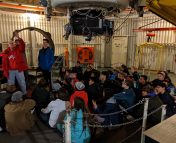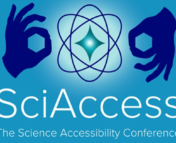
A Balancing Act
In many ways, science communication in the field of astrophysics appears to be an easy task, at first glance.
Astrophysics is the sub-field of physics with flashy images, bombastic concepts and statements. A lot of people feel drawn to the wonders of space and the more philosophical questions astronomy can hint to, such as the question of where we come from, whether we are alone in the Universe or how everything first started.
But once we start to build a bridge between astronomical academia and the public, we quickly find pitfalls and a knife’s edge to the balance between staying scientifically accurate and retaining the audience’s attention and comprehension.
We can talk about black holes and the information paradox, but once we crack the surface, there is no circumventing general relativity and other, mind bogglingly complicated concepts, that are absolutely not made to be explainable to a general public audience in under 30 minutes.
And, on top of it all, we all know that the best test of your fundamental knowledge of a topic is the challenge to explain it to someone else.
So, contrary to what it may look like on the surface, explaining astrophysics to the public, and especially to kids, often requires a full immersion into the depths of a certain topic, understanding a shocking amount of details, just to be able to break it down without losing accuracy on the way.
Steps for Successful Communication
For a little over six months now, science communication has been my job, ever since I left academia for a position at a public observatory, giving tours and holding talks.
In this article, I would like to share my experiences and what I learned about effectively explaining astrophysics to interested people from all demographics and backgrounds.
Number 1: Know your audience
It is vital to understand who is in front of you. Of course it makes a difference, whether you are talking to a Kindergarten group or a couple of senior citizens out on an afternoon trip. But more importantly, you will want to get a feeling for the amount of knowledge and previous interest each individual carries already. It is important to play into the fascination someone has already for the topic and show appreciation for all the things they already know, but at the same time, there may be people in the same group who have not previously concerned themselves greatly with astronomy and simply tagged along. These people need to be pulled along if possible and given chances to ask questions and develop their own interest in this field.
Number 2: Keep it casual
Those of us who had the privilege to go to school probably all experienced boring lessons and dry recitation of equations and concepts. We don’t want to transport people back to their physics class with a sense of fear of failure and self-doubt.
I always make it a point to show that physics is so much more than what we learn in school, where fundamental concepts are prioritized over interesting sub-field of physics.
I found it vital to reassure people, especially adults, that bad grades they might have had in math class does not mean they cannot understand the ideas of astrophysics. While mathematics is our toolbox, no one is inherently “too stupid for maths”. It all depends on how something is explained. The words that make me understand a concept might be the wrong ones for you. If you don’t understand something, I need to find different or better words.
Pretty much all equations vital in astrophysics have physical applications, because, well, we are doing physics. So even if you don’t understand what a tensor is, I can still explain general relativity.
Number 3: Always return to flashy images
I know there are hundreds of memes out there, making fun about how astronomy (in regards to other fields of physics) enjoys a special position among the public because it has “pretty pictures”.
What can I say? It’s true! I would be lying if I said that these beautiful and breathtaking photos from for example the Hubble Space Telescope had nothing to do with me going into astrophysics. Instead of dismissing the beauty of these observations of nebulae and galaxies and only stressing their fundamental meaning and how they change our understanding of the Universe, we should lean into the public’s love for these images. Lean into the galaxy print leggings and phone cases, because astrophysics can be both: pretty images and ground-breaking physics. One does not negate the other.
I always try to start out by enticing the audience with the beauty of space. All of it! The planetary nebulae, the exoplanets, galaxies and galaxy clusters,… It’s all out there, surrounded by the inky void. It would be beautiful whether or not we ever gazed upon it (or would it? That’s up for philosophical discussion, I guess!).
And after that, I lead over to what it all means: it gets even better: these radiant, unbelievably graceful and sometimes greatly energetic and violent features of our Universe can answer questions. They shed light on our origins, possible futures, phenomenons we observe here on Earth and about the uniqueness of life, the planetary system we live in and our host star.
What I am trying to say here is, lead from a fascination that is already there about wonderful imagery to the breathtaking scientific backgrounds of these objects and phenomenons. Build off of the energy people already bring to you. There is nothing wrong with swooning over pretty pictures or crazy concepts.
At the end of a talk or an explanation, I always try to come back to a colorful observation or mind boggling implication. Because we want to instill a sense of fascination for astrophysics, don’t we?
Number 4: Let’s talk
Science Communication works best when it’s a discussion, not simply a lecture. I always try to engage in conversation with the audience, either by their questions or by asking them how they would explain something, about their estimates for certain things or open problems in astronomy, such as the question of life out there in the Universe.
Science is all about using our minds to understand nature and we can make audiences engage with that by including them in conversation and leading them into the way of scientific conduct. It is quite easy to show how scientists work this way, just by guiding a public audience down the same mental roads and exploring scientific problem solving. That doesn’t mean you need to expect your audience to prove the grand unification theory after your talk, but that you introduced them to the way of scientific work and thinking.
Sharing is Caring
Science, in general, is not an opinion or a feeling. It is what makes humans so unique on this planet. It is what largely brought us to where we are today.
Science communication is vital if we want to ensure further public funding and trust for science.
There are already so many great science communication projects out there and it never hurts to add more to them. Public outreach is vital for institutions who want to ensure young people decide to go into this field and someday work in research.
Science communication can be the reason for a young student to discover their own interest in science and consider studying physics. It may be a way to make people feel included in science and consider the portion of their tax money, which goes to research, well spent. It may light a spark in someone, who finds a great new hobby.
It may be many things and all of them are worth the effort.
As in so many other aspects of life, the key to success often lies in effective communication.
Astrobite edited by Zili Shen
Featured image credit: own creation




